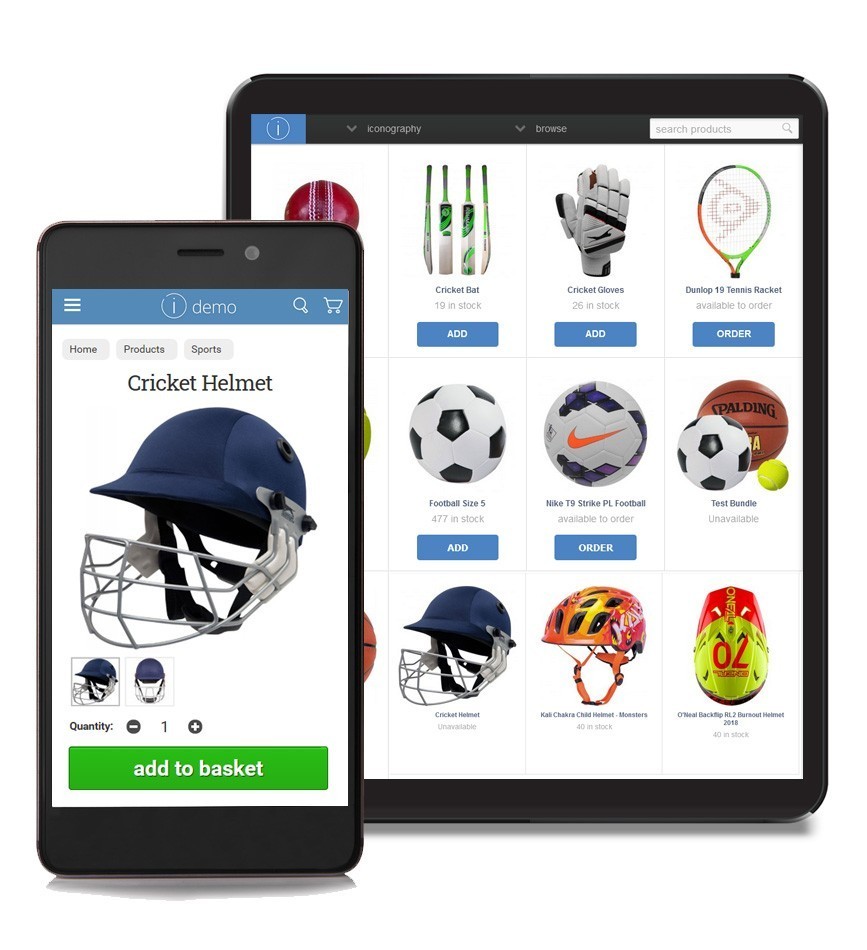10 steps to improve omnichannel customer experience
Stores re-opening
Retail footfall is steadily increasing as Covid restrictions unlock, making now a critical time for retailers with physical outlets to flex their omnichannel muscles and show consumers why shopping instore is better than ever before.
According to eConsultancy, Omnichannel retailers were the biggest winners in January 2021, seeing a 99.8% year-on-year rise in sales across their online channels compared to their online-only counterparts, which experienced 31.2% growth.
Clearly, the consumer has shown that ‘multi-channel’ models, where channels work independently of each other, are no longer in favour. Therefore, it’s retailers offering a connected shopping experience with services including click and collect, buy online-return to store and cross-channel loyalty programmes that are securing much-needed revenue on the high-street and online.
OMNIS by Iconography
Did you know that our Unified Commerce platform mixes eCommerce, RMS, CRM and EPoS to provide an award winning omnichannel solution?
Implementing & improving the omnichannel customer experience
A great omnichannel experience starts with your Retail Management System (RMS). With the right systems in place that talk to each other, share data with each other efficiently and without error, then you can craft omnichannel customer experiences that delight your customers, secure repeat purchases and build brand loyalty.
These 10 steps to omnichannel success will help to provide clarity and focus on what’s preventing you from increasing sales by offering the omnichannel experience that customers now expect when shopping online, instore and a combination of the two.
1. Clearly define and understand your customer profiles
Be sure that you understand the type of people who you want to attract and buy from you. Do you know what their age profiles are, their interests and how they behave? Are they a homogeneous or diverse group in terms of age and socioeconomic or psychological profile? Are they who you expected them to be? Are you happy with your positioning in relation to their number and spending power? Are there other target customer profile options available to you? If you are going to meet their needs then the better defined and the deeper the profiling, the better you will engage with them.
2. Map & understand the customer journey
Playing an active role in the customer journey is critical if you want to improve Omnichannel Customer Experience. Typically there are at least two or three touchpoints across websites, social media or instore, where customers interact with and engage with your brand and the customer experience you have mapped out. Bear in mind most of your customers will start their search using a smartphone. And there’s a good chance they will be using it when they're in your store. Knowing the customer journey means you can ensure there's a unified and consistent experience awaiting them. This means sufficient product information, accurate stock and delivery information and personalised messaging.
Many customers will actually start their search using a smart phone & there's a good chance this will be when in store
3. Review your existing systems and set-up
Researching and understanding what's happening with your current systems will give you a strong platform to improve omnichannel customer experience. Ongoing and regular review is vital to keep pace with evolving omnichannel retail strategies and will help continuously improve the shopping experience.
Some of the key questions relate to how the core components of the current solution integrate with other key aspects of your business. For example, how do your retail management systems talk to your back office accounting systems? What are the unfulfilled needs? What levels of technical support do you require and what are they costing you? How could this be improved?
4. Define internal pain points and system restrictions
Old systems are often at full stretch and nearing breaking point. Therefore be realistic about what you have. Is it likely the existing systems can improve omnichannel customer experience? For instance: How often does poor inventory management cause you to lose sales? Do you suffer from master data issues where there's two separate datasets for offline and instore sales? Do you lack the basic tools needed to record customer information, their order history and interactions with you?
It's important to identify features and functions that you're missing and to be aware of what you could have. Because technology moves on very rapidly, what was not required or even possible a few years ago is now the baseline. When reviewing new RMS software solutions consider the technology choices vendors have made during the design and build of their systems. These choices matter for reasons of interoperability, performance, scalability, security and cost.
5. Connect/upgrade your retail systems for better data sharing and visibility
To deliver the experience that customers now expect requires real time and instant access to information regardless of where that customer engaged with you. One of the key problems still facing retailers is that there remains a historical reliance on separate software and systems that create a complicated patchwork of disconnected eCommerce, EPoS, CRM and Retail Management Systems .
A Unified Commerce system delivers instant visibility with no need to move data around. It’s fundamental to any effort to improve omnichannel customer experience. It enables a customer shopping online or instore to have access to the same information so they can complete their purchase using any channel. This simply isn't possible when information is siloed and systems are working independently of each other.
.jpg)

6. Ensure customer services are in the loop
Chatbots on websites are a very cost effective means to improve Omnichannel Customer Experience. Their Artificial Intelligence (AI) is increasingly sophisticated and can morph easily into meaningful human interactions. Make sure they are a help and not an annoying hindrance. And when a customer switches between channels ensure the experience is coherent and connected.
This means an accurate CRM history of interactions, purchases and responses to marketing. Augmenting your staff skills with systems training as well as ongoing call handling and problem solving skills will definitely improve Omnichannel Customer Experience.
Try to avoid chatbots becoming an annoying hindrance rather than a helpful aide to users
7. Add additional shopping-related services (click & collect)
The possibility to do things that you could not do before is a prime motivator for an upgrade of your RMS. Until the technology offered it to them, customers never knew they wanted to shop across multiple channels, buy online, return instore, check stock in different locations and more. These are the key measures of a drive to improve omnichannel customer experience.
A unified omnichannel commerce approach brings all the core marketing and sales channels together into one platform. This means customers can start and stop their shopping journey as required with all of their information captured and retained for when they want to pick it up again. It’s only with a centralised and real-time approach to data management, inventory and distribution that customers can genuinely shop when they want, how they want.
8. Build data-driven marketing campaigns
Effective data driven marketing leads to increased conversion and customer acquisition. But it’s not straightforward and requires a unified approach to data if it’s really going to improve Omnichannel Customer Experience. Personalisation now goes beyond the direct communications like email. Consumers now expect personalised ads, unique product recommendations, individually targeted discounts and even bespoke homepages when they visit your website. Without the relevant data harvested from a unified omnichannel approach this is impossible to achieve. Starting with sales histories, what products are they buying most? What customer service interactions have they had. What actions have they taken on your website, surveys completed, updates requested? Gather it and use it.
9. Implement a customer loyalty programme
It may be that you are already running successful loyalty programmes in different channels. Centralising your data allows you to integrate online and offline loyalty programmes. A loyalty programme will make it more likely a customer will stay with a brand. Helping customers to move freely between all touchpoints, taking their loyalty points and rewards with them is critical.
10. Review your shipping and returns policy and process
You might well have done work on this already and think that you’ve got it covered. Often though there’s still some friction that could be taken out of the process so it pays to keep it under regular review. While free shipping is the customer’s ideal, it’s a significant cost to you and so use it sparingly. Seek out solutions that offer best value in terms of price and speed of delivery.
It’s obvious that a really good returns experience builds loyalty and increases the likelihood of a customer returning. Deliver a poor experience and you can seriously put people off shopping with you again. Systems wise retail staff need to be able to see eCommerce orders on POS systems and devices. Payment gateways need to allow refund to original payment. The return should amend the original order and the inventory status should be accurate and clear.
Iconography can help
Succeeding in omnichannel retail means making the right investments in systems that allow a single view of the customer, inventory, and orders so that you can deliver the end-to-end experience customers expect. In the 2020s this is no longer a competitive advantage, but a basic requirement to thrive.
We have over 20 years of experience in helping retail businesses grow their business across all channels. For more advice about improving the omnichannel customer experience in your retail business and choosing omnichannel software that delivers, contact a member of the Iconography team today.
OMNIS Retail
OMNIS was born out of the needs of a leading direct to consumer brand to support their online and instore retailing formats in the UK market. They were facing the same problems and challenges that present obstacles for any retailer.
As a progressive and forwarding thinking brand, our client wanted to remove the limitations, constraints and operational inefficiencies associated with integrating an eCommerce website with offline EPoS and legacy back office retail software.
We quickly saw the vast potential OMNIS possessed. It’s a need we’ve recognised with many other retailers and DTC brands that have similar aspirations and want to remove the restrictions of old retail technology and software.
In OMNIS you can create multiple warehouses with any number of locations, place purchase orders and complete stock transfers. We have a full range of reporting and administrative control suite. Together, these give you complete control and oversight over your stock across all channels.


Online and instore retail
OMNIS Retail is a pioneering new retail solution that has been driven by D2C brands & niche retailers looking to the future. A single database eliminates any data integration issues between outdated systems, instead providing a cloud-based omnicommerce retail solution fit for the 21st century.
29th June 2021
Everyone is super helpful all the time, always helping us understand what we need to do and what we are asking you to do.
Natalie Lewis, Washware Essentials
Get in Touch